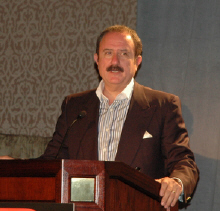Phone futures in review

I'm at Mark Anderson's Future in Review conference in San Diego, and first topic of the day is the future of phones. Bandwidth is no longer and issue, although the U.S. is still behind South Korea, Japan and other countries where households have up to 100 megabit per second service. Cable companies like Comcast are challenging AT&T and Verizon, and the U.S. government economic policy is centering around broadband.

Unfortunately for Trujillo, the pipe holders don't control the user interface, and all the device makers want to have it there own way. He went on to give the standard "listening to customer needs" advice and the desire to get to a point where manuals can be discarded. "You are not the problem," Trujillo said addressing the audience, "there are too many buttons, menus, steps...it's too hard and must be simple, easy, intuitive and relevant to customers' lives." He admitted the Telstra isn't the right company to solve the problem, but said that he is trying to show some of his supplier the way...
Paul Jacobs, the CEO of QUALCOMM, predicted that within five years, the phone would have multiple radios, 3D games, biometrics, and support financial transactions. He said his company is a building 2-gigahertz processor that users a twentieth of the power of an Intel process, and will be available in the next few years. In addition, memory prices are coming down, high speed wireless LANs are coming to phones, multiple radio outputs, RF control of any device, authentication so that the phone is a digital wallet, distance learning services and other capabilities that will make the phone no longer worthy of being called a 'phone.'
Mark Anderson and Paul Jacobs
Like Trujillo, Jacobs noted that the user interface has to be adaptive for different applications. Anderson asked Jacobs whether phones would learn from user behavior. "I suppose you can do those things, but you always have to worry about surprising the user," he responded. That kind of capabilitity is more likely to come from OS and applications vendors like Microsoft. Jacobs doesn't expect continuous, untrained speech recognition with 99.9 percent accuracy to be available any time soon. He expects that speech recognition with constraints, with users providing prompts and feedback to train the system is more realistic.
Experiments in form factors, blurring the lines between laptops and palmtops, will continue as the device makers look to create the next iPod-like, hit product phenomenon, and with high bandwidth networks, the location files, memory and processing won't have to be totally tied to the device in your pocket.